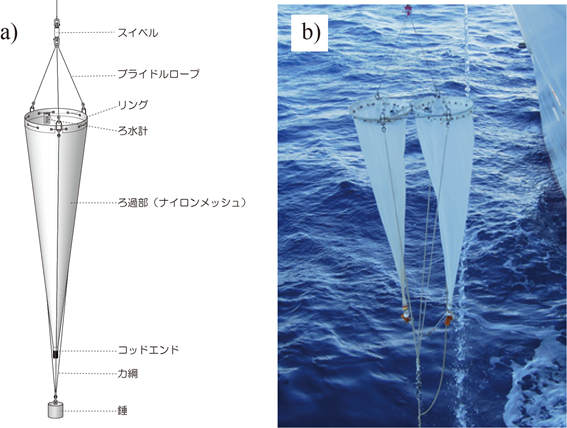Biological collecting
トピックアウトライン
-
Various organisms inhabiting the ocean are collected for the purpose of research on the physiology and ecology of marine organisms, surveys of fishery resources, and clarification of the material circulation system via biological pumps. As shown in Figure 1, marine organisms are classified into three categories according to their mode of life: surface organisms (Neuston) that live above and below the ocean surface, organisms drifting in the ocean (plankton), swimmers (Nekton) that can swim freely and move by themselves, and benthic organisms (Benthos) that live on the sea floor or in sediment, each of which uses specific collecting tools.
Fig. 1 Classification of marine organisms by mode of life
海面: sea surface 水中: underwater 海底: bottom of the sea
-
Plankton are organisms that have little or no swimming ability and live by drifting in the water. Plankton can be broadly classified into plant species such as diatoms and dinoflagellates and animal species such as copepods and jellyfish. Organisms that live temporarily suspended in the water during their growth stages (life history) are also considered to be plankton such as fish fry, larvae of crabs, starfish, and sea anemones.
There are two ways to collect plankton: by using a nylon net called a plankton net or by collecting water.
-
Nektons are the organisms that have the ability to swim and live freely in the water, including many fish, cephalopod squids, and marine mammals such as dolphins and whales. These nektons are collected by quantitative sampling tools developed for research and surveys as well as by commercial fishing gear and fishing methods.
-
Organisms that live on the seafloor surface or in the sediment (mud and sand) are called benthos. They include organisms from diverse taxonomic groups such as seaweed, sea anemones, corals, shellfish, gobies, starfish, and flatfish.
Benthos can be collected by dragging a net or bucket across the seafloor or by using a mud sampler to collect the entire sediment that is their habitat. The efficiency of collecting organisms with a mud sampler depends on the hardness and characteristics of the bottom sediment (e.g., sediment or gravel), but compared to the method using a net, it is possible to obtain samples of organisms living below the seafloor surface, i.e., in the sediment.
Collecting large benthic fishes requires the use of large commercial fishing gear, such as otter trawls, which require extensive specialized fishing equipment and experience. The collection gear used for research is designed to be used by research vessels without fishing equipment.
-
Sea water strider, flow algae, and other organisms that live while floating on the surface of the water are called neuston. They are collected with a net called a neuston net, which is used to tow them across the surface of the water.
Fig. 10 Neuston net
The net is towed on the sea surface to filter seawater and collect neuston. Since floats are attached to both sides of the frame, the net can be towed while always catching the surface of the water without the net mouth being submerged in the water.
曳航ブーム: towing boom 曳網索: towline ブライドルロープ: bridle rope フレーム: frame
浮子: float 網: net コッドエンド: cod-end



